Transformers
Related wiki pages: Capacitors, Inductors, Resistors
A transformer is a passive device that is used to transfer electrical energy from one circuit to another - or from one part of a circuit to another. This is achieved by coupling two conductors inductively. In this arrangement a changing electric current in one conductor creates a changing magnetic field. This in turn creates a changing magnetic field in the second conductor which creates a corresponding changing electric current in that conductor. For this reason, transformers only work on Alternating Current circuits (AC)
To achieve this inductive coupling the two conductors have to be either physically close to each other, or better still, as used in a transformer, be wound as coils either one within the other or "connected' by a metal (frequently iron) core.
In the diagram below, the "Primary winding' is where the initial changing electric current is applied. The "Secondary winding" is where a changing electric current is formed.
This type of transformer is frequently used to either reduce or increase voltages. The relationship between number of turns in each winding and voltage is:
- <math>
\frac{V_{S}}{V_{P}} = \frac{N_{S}}{N_{P}} </math>
In an ideal transformer (one in which there are no losses, the power on each side of the transformer is equal so, as Power = Voltage x Current ( P = VI )
- <math>
P_{Primary} = I_{P} V_{P} = P_{Secondary} = I_{S} V_{S} </math>
This leads to the ideal transformer equation:
- <math>
\frac{V_{S}}{V_{P}} = \frac{N_{S}}{N_{P}} = \frac{I_{P}}{I_{S}} </math>
This means that if a higher secondary than primary voltage is required, there will be a decrease in secondary current by the same factor.
| Electronic Theory | |
| Physical quantities | Current * Gain * Impedance * Power * Q of a circuit * Radiated Power Measurement * Reactance* Resistivity * Resonance * Voltage |
| Components | Baluns * Bipolar-Junction Transistors * Capacitors * Diodes * Inductors* Lasers * Microphones * Resistors * Transformers * Wire |
| Circuits | Attenuators * Digital Signal Processing (DSP) * Dummy load * Filters * LC filters * Power Supply Design * Rectifier Circuits |
| Design | Amplifier Design * Oscillator Design |
| Electromagnetic Waves | Relative power (Decibels) * Harmonics * Interference and BPL |
